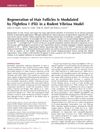Distribution Pattern of Some Glycoconjugates in Hair Follicle Regeneration in Rats
September 2011
in “
Clinical Biochemistry
”

TLDR Certain sugars increase in some layers of the hair follicle during the middle of the healing process in rats, which may help improve healing.
In a study conducted 12 years ago, researchers investigated the distribution pattern of certain glycoconjugates during hair follicle regeneration in rats. The study involved 10 Sprague rats, with skin wounds of 4mm induced on each rat. The researchers found that from the 15th day, weak intensity of PAS and Alcian blue positive responses were observable in the fibrous root sheath and dermal papilla of follicles, with high color intensity seen gradually until the 40th day. The conclusion was that neutral, sulfated, and carboxylated acidic glycoproteins appeared increasingly from the mid-stage of repairing in some layers of the hair follicle. This specific stage distribution is likely related to different cellular activities that improve healing processes. This understanding of the molecular aspects of tissue regeneration could be used in pharmacology or tissue engineering.
